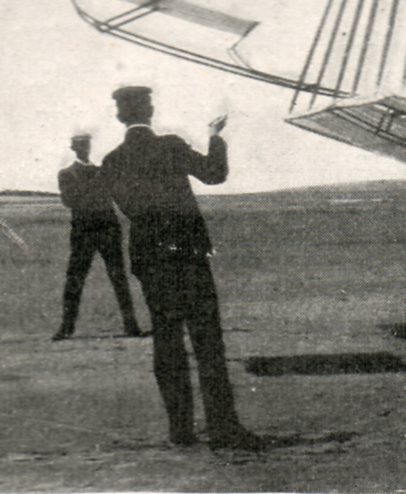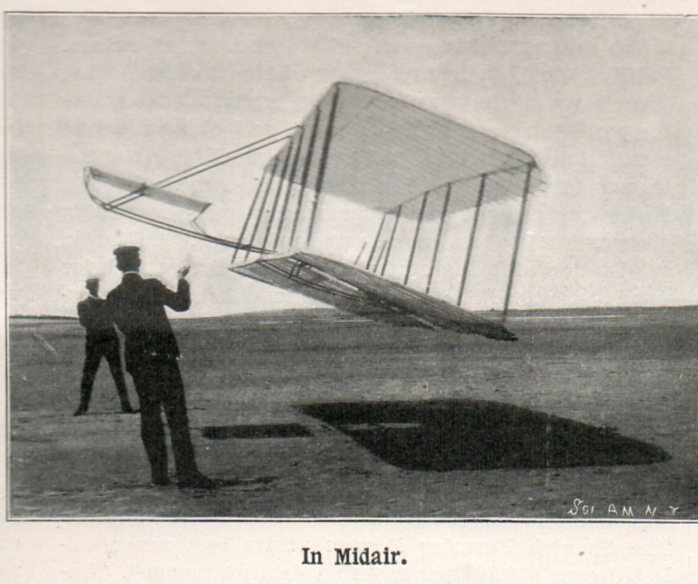JF Ptak Scienc Books Post 1485
In this history of picturing shadows this might be one of the most significant for early 20th century technology. After all, shadows in images weren't necessarily a desired effect, and certainly it was seldom required, but this one, captured as a result of capturing something else, has survived.
This is one of the first popular reports on the Wright brothers' first publication describing their experiments in flight., and it is buried in the middle of The Scientific American issue for 22 February 1902, months after the original publication. That initial report, published as “Some aeronautical experiments” published in the even-then-obscure Journal of the Western Society of Engineers (6 (1901) 489-510) seems to be the only source for this article, the Wrights keeping information about their experiments closely held. (For example, the next publication of theirs, “Experiments and Observations in Soaring Flight" would be published in the Journal of the Western Society of Engineers ,VIII, 400-417, in 1903.)
The editors of the Scientific American—and other magazines—were certainly skeptical when it came to claims of new sorts of flight, but the Wright case seems to have been thoroughly without question. Still the article on their article appeared in this issue of the magazine after stories on the reconstruction of the RedHeugh Bridge, reviving the Hudson River tunnel idea, steam boiler inspection, the Darien canal, variable speed gears for pumps, a new method of etching, “photographing by electric headlight”, mill flour in Sweden, domestic manufacture of Portland cement, improved rail joints, winter railroading in Alaska (and a few other bits), before we get to the article, which is just a half-page long.
Bit it is an important half-page, which include five photos of the fliers as well as descriptions of the control apparatus, which includes an observation of an epochal improvement to their aircraft, one of the most important in the history of aviation (if I am not mistaken):
“...responding to the slightest motion of the rudder”
That is to say changes were made to the rudder which paved the way to their 1902 experiments on the vertical rudder, which gave it a critical importance of keeping the aircraft aligned when coming out of a banking maneuver or climb rather and so on than for changing the direction of the aircraft; so when using the rudder in this way and wing warping for altering direction, their aircraft would became a truly flyable thing.
Notes:
Since this is outside my area I quote liberally from the US Commission on the Centennial of Flight for a more exact description of the difference of the gliders between 1901 and 1902:
“Their 1902 glider had a new wing with a shallow camber and high aspect ratio. It was a major departure from their earlier machines. It had roughly the same wing surface area as the 1901 machine, but the similarities ended there. The wingspan was ten feet (three meters) longer and the chord two feet (0.6 meter) shorter than the old machine, making the glider look larger and more graceful. It had an overall length of 16 feet (5 meters) and weighed 112 pounds (51 kilograms). The wing camber followed a shallow parabolic curve, and the elevator was extended farther out in front of the pilot. This gave it more leverage, which allowed better control. The 1902 glider also had a new rudder that consisted of two fixed vertical surfaces located behind the aircraft . Wilbur and Orville calculated that these would help prevent the skidding that had occurred when they warped the wings.”
And the following on the 1902 flights from
Orville Wright “How We Made the First Flight”: “The flights of the 1902 glider had demonstrated the efficiency of our system for maintaining equilibrium, and also the accuracy of the laboratory work upon which the design of the glider was based. We then felt that we were prepared to calculate in advance the performance of machines with a degree of accuracy that had never been possible with the data and tables possessed by our predecessors. Before leaving camp in 1902 we were already at work on the general design of a new machine which we proposed to propel with a motor






Comments